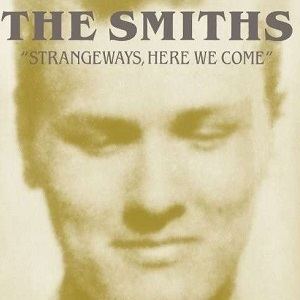Released 28 September 1987 Length 36:37 Strangeways, Here We Come(1987) Stop Me(1988) Release date 22 September 1987 | Recorded Spring 1987 Label Rough TradeSire | |
 | ||
Similar The Smiths albums, Alternative rock albums | ||
Strangeways, Here We Come is the fourth and final studio album by the English rock band the Smiths. Released on 28 September 1987 by Rough Trade Records, it reached number two on the UK Albums Chart, staying in the chart for 17 weeks. All of the songs were composed by Johnny Marr, with lyrics written and sung by Morrissey. The album was certified gold by the British Phonographic Industry on 1 October 1987 and also by the Recording Industry Association of America on 19 September 1990.
Contents
- Recording
- Artwork and title
- Release
- Critical reception
- Track listing
- Personnel
- Production
- Chart positions
- Songs
- References
Slant Magazine listed the album at No. 69 on its list of "Best Albums of the 1980s", writing that "Whether or not Strangeways, Here We Come ended the Smiths' brief career with their best album has been the subject of considerable debate for nearly a quarter century, but it definitively stands as the band's most lush, richest work."
Recording
The Smiths recorded what was to be their final studio album at The Wool Hall studios in Beckington, Somerset, England (established and then-owned by the band Tears for Fears). Between the album's recording in March and its release in September 1987, Johnny Marr exited the group, ending the band. Strangeways is the only Smiths album to feature Morrissey playing a musical instrument: piano in the song, "Death of a Disco Dancer".
Marr felt the band was ready to enter a new musical phase, and was determined to avoid formula and move away from their previous "jingle jangle" sound. He started to look for different influences, finding an interest in The Beatles' White Album. The band used synthesised saxophone and string arrangements and drum machine additions.
Recording in The Wool Hall made the sessions more relaxed, as the wine cellar was fully stocked and producer Stephen Street came slowly to understand the idea that the writing partners Morrissey and Marr were trying to put forth. Street (who engineered previous Smiths efforts) later said that after the recording days there would always be late-night drinking. "That was always after Morrissey had gone to bed ... it wasn't really his bag. We'd carry on finishing overdubs and then the records would come out. We'd be partying all hours." Marr would later defend this by saying "But only after ten or twelve hours of making some really good music, not as a substitute ... It wasn't all one Spinal Tap mongo fest!"
Morrissey and Marr feel the album is the band's best, with Morrissey asserting that, "We say it quite often. At the same time. In our sleep. But in different beds."
Artwork and title
The sleeve for Strangeways, Here We Come, which was designed by Morrissey, features a murky shot of East of Eden co-star Richard Davalos. Davalos is looking at James Dean, who is cropped from the image. Dean was a hero of Morrissey's, about whom the singer wrote a book called James Dean Is Not Dead. Five years later, when designing the sleeve for WEA's Best compilations, Morrissey again chose Davalos as a cover star, and Davalos is looking at Dean, who is once again cropped.
As revealed in Jo Slee's collection of Smiths and Morrissey sleeve artwork, Peepholism, Davalos was not the original choice for cover star. Morrissey wanted to use a still of Harvey Keitel in Martin Scorsese's I Call First (also known as Who's That Knocking at My Door), but Keitel declined to allow him to use the image. In 1991 Keitel relented, and the image was used on T-shirts and stage backdrops for Morrissey's 1991 solo tour.
The album takes its title from Manchester's notorious (and now renamed) Strangeways Prison, whilst the line "Borstal, here we come" is taken from the novel Billy Liar. "Strangeways, of course, is that hideous Victorian monstrosity of a prison operating 88 to a cell," Morrissey has explained.
On the title, Marr has said "I've learned to love the title ... it was a bit overstating things somewhat. A little bit obvious. But it's OK. I was always intrigued by the word Strangeways. I remember as a kid, when I first heard that the prison was really called that, I wondered had it not occurred to anybody to change the name? It's still befuddling, really." Morrissey has also stated, "Really it's me throwing both arms to the skies and yelling 'Whatever next?'"
Release
The album rose to No. 2 on the UK Albums Chart and No. 55 on the US Billboard 200.
Two final songs were recorded in May 1987 to provide B-sides for the album's lead single, "Girlfriend in a Coma". Two more singles were taken off Strangeways, Here We Come; their B-sides were drawn from archival recordings.
Critical reception
Reviewing the album for AllMusic, Stephen Thomas Erlewine said it was "a subtly shaded and skilled album, one boasting a fuller production than before ... while it doesn't match The Queen Is Dead or The Smiths, it is far from embarrassing and offers a summation of the group's considerable strengths."
Track listing
All tracks written by Morrissey and Johnny Marr.
Personnel
Production
Chart positions
Album
Songs
1A Rush and a Push and the Land Is Ours3:00
2I Started Something I Couldn't Finish3:48
3Death of a Disco Dancer5:26
